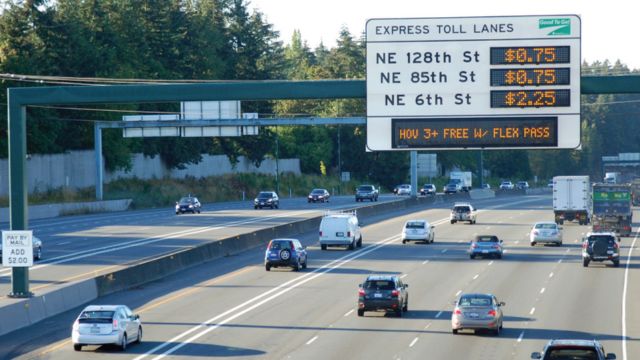OLYMPIA—Starting March 1, tens of thousands of commuters using the I-405 and SR-167 may expect to pay 33-67% more in tolls for their daily commute. In a Special Meeting on January 29, 2024, the Washington State Transportation Commission approved the proposed Phase 1 toll rate adjustments for the I-405 Express Toll Lanes (ETLs) and SR 167 High Occupancy Toll (HOT) Lanes, which will take effect on Friday.
The reason for the tariff hike is that too many commuters use the toll lanes. Deputy Director Carl See stated at the meeting that increased traffic congestion impacted performance targets, resulting in less money for enhancements to previously awarded corridor projects. Travel times in general purpose (free) lanes have increased by 3-9 minutes, or three times that of tolled lanes. The goal is to move more commuters out of toll lanes and into general-purpose lanes, reducing travel time in these lanes. This would increase travel time for general commuters while incentivizing them to use mass transit.
The Commission’s first rate hike in nearly ten years—2008 for SR-167 and 2015 for I-405—is estimated to earn an additional $4.8 million to $8.3 million in revenue between March 2024 and June 2025. The toll rate adjustments listed below will take effect on March 1, 2024, as follows:
Increase the minimum toll fee to $1 (up from 75 cents, or 33% increase for I-405, and from 50 cents, or 100% increase for SR-167).
Increase the maximum toll fee to $15 (up from $10, a 50% increase for I-405, and a 67% increase for SR-167).
Increase evening tolling and peak hour HOV rules by an hour, to 8:00 p.m. The lanes will now be free on weekends (just on I-405) and overnight from 8 p.m. to 5 a.m.
According to Deputy Director See, the Legislature asked the Commission in the 2023-2025 Transportation Budget to assess toll revenue performance in the corridor and urge tariff adjustments. In 2022, WSDOT reported that I-405 had approximately 125,000 daily commutes (approximately 60,000 vehicles), while SR-167 has 130,000 commutes (approximately 65,000 vehicles).
According to the Commission, the hike on I-405 is estimated to affect 71% of all commutes, with 4% falling below the maximum toll rate.
The Commission’s first rate hike in nearly ten years—2008 for SR-167 and 2015 for I-405—is estimated to earn an additional $4.8 million to $8.3 million in revenue between March 2024 and June 2025. The toll rate adjustments listed below will take effect on March 1, 2024, as follows:
- Increase the minimum toll fee to $1 (up from 75 cents, or 33% increase for I-405, and from 50 cents, or 100% increase for SR-167).
- Increase the maximum toll fee to $15 (up from $10, a 50% increase for I-405, and a 67% increase for SR-167).
- Increase evening tolling and peak hour HOV rules by an hour, to 8:00 p.m. The lanes will now be free on weekends (just on I-405) and overnight from 8 p.m. to 5 a.m.
- According to Deputy Director See, the Legislature asked the Commission in the 2023-2025 Transportation Budget to assess toll revenue performance in the corridor and urge tariff adjustments. In 2022, WSDOT reported that I-405 had approximately 125,000 daily commutes (approximately 60,000 vehicles), while SR-167 has 130,000 commutes (approximately 65,000 vehicles).
According to the Commission, the hike on I-405 is estimated to affect 71% of all commutes, with 4% falling below the maximum toll rate.
Key Operational Rules
- Tolls and occupancy requirements apply solely during each facility’s operating hours.
- Both facilities are open Monday through Friday from 5 a.m. to 8 p.m. (as of March 1), with SR 167 HOT lanes open on weekends as well.
- Carpools of two or more persons are exempt from tolls on both I-405 ETLs and SR 167 HOT lanes, except during peak periods of 5 a.m. – 9 a.m. and 3 p.m. – 8 p.m. (as of March 1) on I-405 ETLs, when only carpools of three or more people are exempt. Motorcycles, transit vehicles, and vanpools will all be exempt.
- Drivers without a Good To Go! account can utilize the I-405 express toll lanes and will be billed in the mail for their journey. Drivers who select this option will pay $2 more than the listed Good To Go! rate in force at the time of the journey.
Tolled Lanes Provide Benefits
- Travel time reliability: Demonstrates the preference for a speedier and more reliable trip, as well as support for more dependable transit service.
- Effectively handles congestion in real-time: Toll charges are adjusted based on real-time traffic circumstances to support an average speed of at least 45 mph in the ETL/HOT lanes.
- Contributes to future congestion relief: Revenues fund present and future enhancements to the I-405/SR 167 corridor, as well as facility operations and maintenance.

